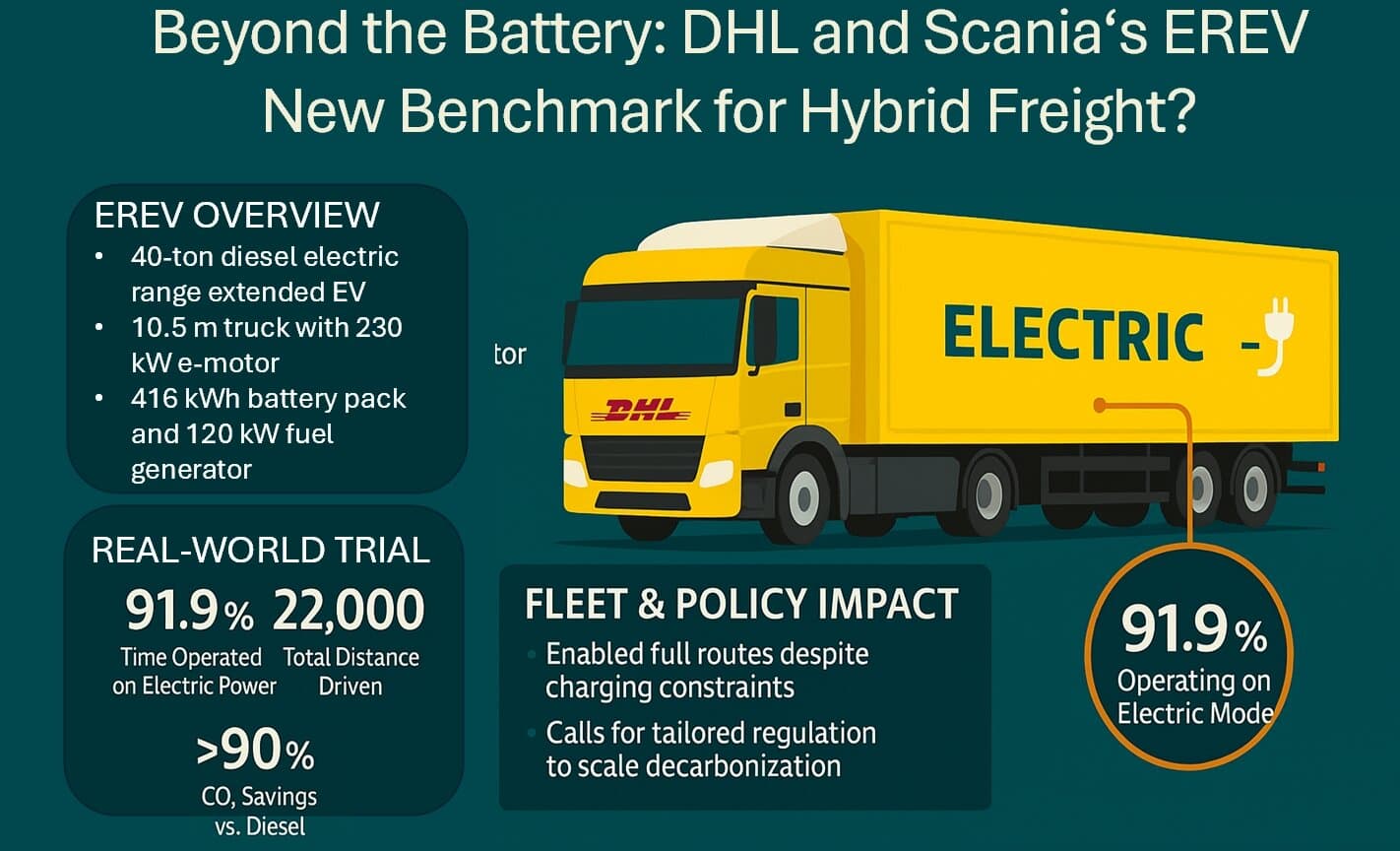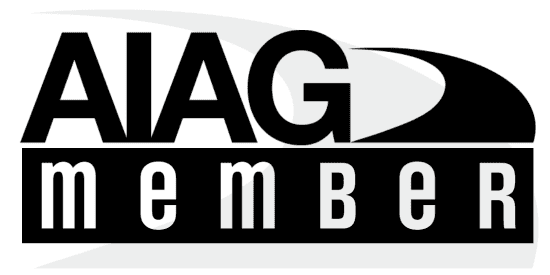Plug, Drive, Repeat: DHL’s Game-Changing E-Truck Proves Hybrid Power Still Matters

picture/infografics: Hybrid Alliance
Abstract
DHL and Scania’s Extended Range Electric Vehicle (EREV) has emerged as a pragmatic solution in commercial logistics, offering significant emissions reductions while preserving operational flexibility. After 100 days and nearly 22,000 km of real-world testing between Berlin and Hamburg, this novel range‑extended electric truck demonstrated over 90 % CO₂ savings compared to conventional diesel, operating 91.9 % of the time on electric power and using its onboard fuel generator for just 8.1 % of the route. This article explores the technological innovation behind EREV, its strategic implications for fleet decarbonisation, and the critical need for policy evolution to support such transitional powertrain solutions.
Executive Summary
- Performance Insights: The 10.5 m, 40‑ton EREV, powered by a 230 kW electric motor (295 kW peak) and 416 kWh battery pack, completed its first test phase with remarkable efficiency—emitting 90 % less CO₂ than a diesel truck and saving approximately 16 tonnes over 22,000 km.
- Range Extension Strategy: The 120 kW onboard fuel generator does not directly power the wheels. Instead, it acts exclusively as a backup battery charger, preserving pure-electric operation while alleviating range anxiety .
- Fleet & Infrastructure Benefits: The EREV’s blend of BEV performance and ICE-fuelled flexibility allows for uninterrupted route execution despite challenges like limited charging infrastructure or winter conditions
- Regulatory Needs: DHL’s CEO Tobias Meyer emphasizes that pragmatic bridging technologies like EREV require regulatory recognition—via proportional road-toll charges and emissions schemes—to scale meaningfully
- Future Trajectory: A next-gen model under development will feature a 520 kWh battery, reducing generator dependence further and opening up even deeper decarbonisation opportunities
1. The EREV Powertrain: Bridging the BEV‑Infrastructure Gap
At its core, the EREV represents a clever synthesis of electric mobility and traditional refuel flexibility. Instead of dedicating space solely to battery packs, one module is replaced with a 120 kW generator that charges the battery when needed—not drive it directly. This allows up to 800 km of range—comparable to Scania’s full-electric truck—while enabling refuelling at any fuel station.
This design preserves the integrity of zero-tailpipe BEV operation where charging infrastructure is available, yet provides an insurance policy for longer or unpredictable routes, especially in early-stage EV infrastructure landscapes—a key advantage over full BEVs in logistics.
2. Real‑World Trial Results: 100 Days of Data
Deployment commenced in February 2025 along DHL’s key Berlin–Hamburg corridor (≈250 km), and by late May:
- Electric mode: 91.9 % (≈20,000 km)
- Range-extender usage: 8.1 % (≈1,800 km)
- Emissions reduction: >90 %, equating to around 16 tonnes of CO₂ saved in just 100 days
These figures validate the EREV as not only technically viable, but operationally effective—delivering both environmental gains and logistical certainty.
3. Strategic Context: PHEV HDVs as Transitional Powertrains
EREVs occupy a crucial strategic niche in the decarbonisation timeline:
- Grid and charging scalability: Full electrification in heavy-duty segments still grapples with grid constraints, charging costs, and seasonal or peak volatility
- Sustainability ramp-up: As charging infrastructure grows, reliance on the onboard generator will decline—especially with higher capacity batteries and renewable fuel options like HVO or biodiesel
- Fleet operator viability: Fleets can begin emissions reduction now, without delaying until infrastructure catches up—a critical consideration for logistics networks under tight delivery schedules.
4. Policy Frameworks: Unlocking Potential
DHL’s management calls for an evolution in regulatory treatment:
- Road-toll reform: Toll systems should be based on actual CO₂ performance, not old diesel-versus-electric binaries.
- Emissions accounting: EU fleet CO₂ targets should consider real-world emission data from vehicles like the EREV.
- Renewable fuel incentives: Generator fuel sourced from renewables could further amplify EREV’s green potential.
Absent such policy adjustments, fleets face misaligned incentives that undervalue transitional technologies.
5. Looking Ahead: Next-Gen EREV and Scaling Pathways
Scania and DHL plan to roll out a second-generation model featuring a 520 kWh battery—over 25 % larger—dramatically reducing generator usage.
Wider deployment hinges on:
- Regulatory evolution: Classification and incentives that reflect real emissions.
- Infrastructure upgrades: Expansion of high-capacity charging to support large BEV and EREV fleets.
- Renewable fuel sourcing: Availability of HVO or biodiesel for generator supply.
When policy, infrastructure, and fuels align, EREVs could provide an accelerated, practical pathway to heavy-duty freight decarbonisation.
Conclusion
Scania and DHL’s EREV trial offers compelling proof that strategic hybridisation can drastically reduce CO₂ emissions now—while preserving fleet operators’ ability to meet logistical demands. It is a transitional technology with real-world delivery benefit and symbolizes a broader paradigm where innovation, infrastructure, and policy coalesce.
What is needed now is policy that rewards such innovation, not hampers it. If regulated thoughtfully, EREVs could jumpstart sustainable logistics—ushering in a new chapter in commercial vehicle decarbonisation.
References
- Parcel & Postal Technology International: “E‑truck with fuel-powered backup generator shows promise”
- DHL Press Release: “100‑day DHL test: New Scania e‑truck with fuel‑powered backup generator saved 90% CO₂ emissions”
- DHL & Scania Press Release (Feb 2025): joint development details
- ESG Times: coverage of emissions outcome
- DC Velocity: operational challenges & quotes


